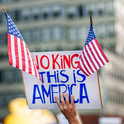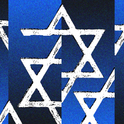At first glance, the room appears familiar: upholstered chairs, a chaise- longue, a mantelpiece adorned with a bust of Queen Victoria. It is a typical study in a comfortable, bourgeois 19th century English home, the setting of many novels and films. Yet something is different. The walls, furniture, even the floors are covered with ornate textiles, but the colours are much brighter than in traditional English homes-luminous greens, oranges, yellows-and the patterns appear exotic. A closer look reveals the figure of a modern black footballer, possibly playing for a European team. What is African here and what is European?
The piece, "Victorian Philanthropist's Parlour" by Yinka Shonibare (see right), has been exhibited in London and at the second Johannesburg Biennale, which opened in October last year. In London, it was shown in an open warehouse-like space; in Johannesburg, it was exhibited on the bottom floor of a large, disused electricity plant, whose massive concrete and steel girders made the study seem more quaint and antiquated. The textiles were designed to look like the printed cloth often used as a symbol of African-ness by black nationalists and white "ethnic chic" designers around the world, even though they were manufactured in Manchester or Holland. Shonibare's use of "African" material is both beautiful and mocking, a comment on Afrocentrism as well as exoticism, and a reminder of the way Europe and Africa often invent each other.
The second Johannesburg Biennale was filled with artworks similar to the "Philanthropist's Parlour"-pieces which comment wittily and poignantly on the nature of post-colonial identities throughout the world. While Shonibare focused on fabrics, other artists used cotton, beans, bottles and photographs. Yet the questions posed by the "Philanthropist's Parlour"-what is African-ness and what is Europeanness and who creates and consumes it?-were at the centre of the tangled identity politics surrounding the Biennale. "What does something African look like?" became the question the Biennale was meant to answer but sought to avoid.
Biennales are large, extravagant events. For national governments they are an opportunity to parade economic prosperity (Biennales are expensive) and enter luxury art markets. For local art elites they are a rare opportunity to make a mark on the international scene. The second Biennale included over 150 artists and more than 200 pieces spread across six venues in two cities (Johannesburg and Cape Town)-an ambitious scheme for Johannesburg, a third world city going broke. The theme, "Trade Routes: History and Geography," was broad enough to cover just about anything, yet specific enough to apply aptly to South Africa.
The Johannesburg exhibitions were scattered around the museums and galleries clustered in the Newtown Cultural Precinct, an industrial area near downtown Johannesburg. The main exhibition was held in the Electric Workshop, an old electricity generating plant converted at great expense into an art space by the Johannesburg city council for the Biennale. During the Biennale's opening night celebrations, Judge Albie Sachs spoke movingly of an African cultural renaissance, where the children of mineworkers would become designers. Hugh Masekela played boldly on the lawn; and a white performance artist wearing a tutu had herself lifted by wires as she dropped light bulbs on to the floor of the electricity plant. Everything operated on a grand scale-except the audience.
During much of the day the exhibitions were quiet. Bored security guards made half-hearted attempts to pick up women passing through the almost empty venues. Although attendance figures increased from the first Biennale in 1995, the number of visitors to Johannesburg came to 40,000 over three months-equivalent to two or three football matches in Soweto's Orlando stadium.
Much of Greater Johannesburg Metropolitan Council's (GJMC) initial funding pledge of over 3m rand was delivered in services rather than cash, leading to regular slow-downs and shortages. At one point the GJMC tried to close the exhibition in mid-December, a month earlier than planned, citing "lack of public support." In the end enough extra money was scraped together so that it could stay open as scheduled, until January 1998.
Finding audiences for the visual "fine" arts is difficult in almost any country. In South Africa, it is even more difficult: the country has to deal with the legacy of apartheid in the arts. Visual arts were not on the curriculum at black schools under apartheid and they are still not offered in Sowetan schools today. Community art centres have sprung up in some townships, but usually they are not part of the gallery/museum system. Although there are now many prolific black artists, their national audience remains largely white. With rising crime, affluent whites have become uneasy about attending city centre venues such as the Newtown Cultural Precinct; while the audience the Biennale needs to court-the black urban workers of Soweto-are not accustomed to attending such events. Many school tours were scheduled, in the hope that the children would come back with their parents. But Michael Jackson's concerts were a bigger draw for hard-earned money than Biennale tickets.
The appointment of Okwui Enwezor as the artistic director of the Biennale was considered by many as an important step. The director of the first Biennale, appointed under the De Klerk government, was white. Enwezor, a Nigerian living and working in New York, was free from any connection with apartheid. His appointment also helped move the Biennale beyond rhetorical lip-service to Africa as the historical birthplace of humanity: a black African was now running the show. Some local art elites were critical, however, insisting that the position should have gone to a fellow national, someone who "understood" the South African situation.
Appointments of Biennale directors are often contentious. They are usually a prize to someone from the host country. The fact that Enwezor has lived for years in New York made him suspect to many South Africans, black and white. Had he spent so much time in New York that he had gone native? Was the Biennale going to reflect anything about South Africa, or was it just another international event controlled by Americans? Some of these concerns about art and identity in the new South Africa are captured in an untitled work by South African artist Marlaine Tosoni (see left). With its pseudo-religious inspirational imagery, the piece suggests the sanctity of South Africa's complicated systems of classification and exclusion. No matter how divided South Africans are among themselves, they share a common ground in their mistrust of outsiders.
The point often overlooked is that South Africa's isolation from the world affected everyone, not simply Afrikaaner nationalists. Only committed ANC activists and affluent whites left-or could afford to leave. Everyone else stayed and lived in relative isolation. Legacies of this enforced ingrown-ness can be found everywhere-from the businessman wary of sponsoring an international event because he has never had to think about his company's global image, to the angry street trader protesting against competition from "foreign" street traders from Zimbabwe, Ghana, Nigeria or Senegal.
Since 1990 the tension between outsider and insider has played itself out in various ways. The contest between Cyril Ramaphosa and Thabo Mbeki to succeed Nelson Mandela was often cast as one between those who stayed and struggled and those who left and struggled. Among the white anti-apartheid community there is the same divide. Today, in some Soweto communities the dichotomy between "us" and "them" is even extended into "us" versus the "African-Americans."
The Johannesburg city government tried to cast the second Biennale in Africanist terms, describing it as "an African event" and "an important opportunity to reconnect with our African roots and redefine ourselves as an African people." Christopher Till, a Biennale selection committee member and director of the first Biennale, explained that Enwezor was chosen as artistic director partly because his proposed theme of "Trade Routes" was thought to have particular resonance for the African continent.
African-ness is a tricky category for white South Africans. Many now insist on defining Africans geographically-you are African because you live on the continent-rather than racially, which would leave them out (and Enwezor in). For some, like the young white professionals hurrying to learn Zulu, interest in African-ness is a survival tactic. It is also a marketing tool: something that South Africa can use to compete in the first world. "If we're not African," explained a white arts administrator, "then we're just like everyone else."
Yet the vogue for African-ness in public life does not extend to African nationals. Most South Africans see "foreign" Africans as a source of trouble: Nigerians are blamed for the drug trade; Senegalese for fraudulent passports. These views are so widespread that many Nigerian professionals try to conceal their nationality. Zimbabweans who leave Zimbabwe as a result of ethnic rivalry often find that they have an equally difficult time in South Africa because they are "foreign."
Okwui Enwezor was thus doubly foreign, being both a Nigerian and a New Yorker. As a Nigerian, he found fundraising in South Africa difficult: "They would laugh and ask me, what are you going to do, snort it all?" His staff, many of them Africans from other parts of the continent but living in the US or Europe, found it wearisome to be referred to as "foreigners" and "outsiders" by black South Africans. English-speaking white Americans or Europeans have an easier time in South Africa: they can pass as white South Africans; Nigerians or Ghanaians cannot-unless they know a local language.
Enwezor himself was adamantly opposed to nationalising or continentalising the Biennale, insisting that the theme was not meant to be "African Trade Routes." Most Biennales are organised around nations. In this Biennale, there were no national pavilions and only one of the six exhibitions was organised around nationality-a presentation of works by South African artists, held in Capetown. Enwezor and his team of curators favoured conceptual art and its step-children: installation work, video art and the CD-Rom-forms which are hard to fit into narratives of national, regional or continental culture. The sensibility they brought to the Biennale was internationalist and global, conceived within a privileged, cosmopolitan diaspora experience.
This internationalist approach did not appeal to everyone. In Johannesburg, many local artists complained about the loss of a sense of place. "You could be anywhere," one painter remarked. Despite the high level of African participation (one third of the 160 artists were from Africa) some felt that it was not enough of an "African" event. There were calls for a director who "knew the local situation," or, at least, lived on the African continent.
Others embraced the internationalism of the Biennale. One artist exclaimed happily that he felt he was "meeting Africans not in Africa, but in the world." This, for many, was the point. Enwezor himself is part of an influential African diaspora intelligentsia which argues for introducing African artists into the international art world as artists, not African artists. They insist that any notion of the "African," whether Eurocentric or Afrocentric, leaves little room for individual experimentation and development. For these artists and critics, the chance to be presented as similar, not different, within an exhibition looking like any other exhibition in London or New York, is a political and professional goal. Imagine being locked inside a room of English water colourists when you want to rip open sheep, and you have some idea of what an artist might feel when others insist that his or her work must reflect their "culture" or African-ness, not themselves.
This diasporic view and experience maps uneasily on to the emerging South Africa. Here, African ethnicities were either enforced by the state, through classification policies and the creation of homelands, or severely suppressed-the elites emphasised their European heritage as part of their power. Being African meant being powerless. To be able to speak openly and positively about an African identity or identities is a novel thing for many South Africans of diverse backgrounds. Previous African identities were legislated by the state-now South Africans have a chance to invent their own.
when invited to participate in the Biennale, artist Fatimah Tuggar approached the South African consulate in New York and asked them for promotional material. From the "approved" calendars and postcards they gave her, she took images and digitally remixed them on a computer. The result is the striking colour photograph "People Watching" (see left).
A truckload of smiling white people sit on a jeep, dressed in khakis, off on safari. They are frozen in mid-smile, some looking straight ahead, others turned to stare at three identical "tribal" women sitting on the ground. The women, dressed in robes and neck rings, stare just as intently back. Wary, bemused and uncertain, they await each other's next move.
Tuggar captures the intense curiosity, uneasiness and hostility with which white and black South Africans often view each other. The computer generated image of three "identical" black women plays with white fears that blacks all look the same and there are too many of them. Yet neither group is carrying guns or weapons. The whites are simply passing by, on holiday, while the blacks sit on dry scrubland. The affluent seaport of Cape Town, a popular tourist destination, shimmers in the distance.
Yet the fear and wariness captured in "People Watching" is not limited to internal affairs; it also echoes South Africa's relationship with the outside world. Whether in the form of new people or new ideas, the outside world is flooding in. Fruit and vegetable stands run by immigrants line the streets alongside Nigerian barbers who bring west African and African-American hairstyles, and a new sense of male vanity. Johannesburg, for so long wealthy but isolated, is slowly reconnecting with the world. Cautious, curious and often hostile, many South Africans are watching to assess the consequences of South Africa's new openness not merely within itself but with the outside world. Wary, bemused and uncertain, they await the next move.
South Africans live in segregated worlds. White Johannesburg has gone underground, into concrete shopping malls with private security guards in the northern suburbs, while black South Africans and recent African immigrants live in the city centre and the non-suburban streets.
The main Biennale exhibition site, Newtown Cultural Precinct, is an area in transition. White South Africans now rarely go there, while many black South Africans know it largely as a transit point for picking up combi taxis (vans). Even Johannesburg's famous Market Theatre, once an important centre for anti-apartheid drama, has had difficulty in attracting the middle classes-mostly (but not exclusively) white audiences-upon which it used to depend. Last year, the theatre's black director personally shook the hands of audience members as they walked out, thanking them for coming.
For South Africans, talking about African-ness is a complicated way of expressing the feeling that South Africa is their home-they have nowhere else to go. In a country of forced resettlement and physical separation of families, a home is a political place. As a nation, South Africa can be seen as redefining its place in the African continent, rather than Europe.
But what is this African-ness that many South Africans are reaching for? As the "Victorian Philanthropist's Parlour" elegantly illustrates, many ideas about African-ness were invented in the interchange between Europe, Africa and the Americas. They reflect the history of a continuing, often unequal relationship. African footballers are now the mainstay of several European teams, just as enslaved African labour helped create both the wealth of the Victorian philanthropist and the need for his or her philanthropy.
What is clear is that South Africans want to tackle these issues among themselves. Answers found in other parts of the world may not apply. In the build-up to the Biennale, Enwezor repeatedly insisted that black history was for black artists only. It is the sort of sentiment that would go down well with a predominantly African-American audience in New York or "Chocolate City," as Washington DC is affectionately known. South Africa's art world fumed. Weren't white artists also South Africans? Black identity politics as practiced in the US does not always translate well into South African circumstances. While African-Americans may prove to be an important source of support for the new country, their experience cannot provide all the answers.











